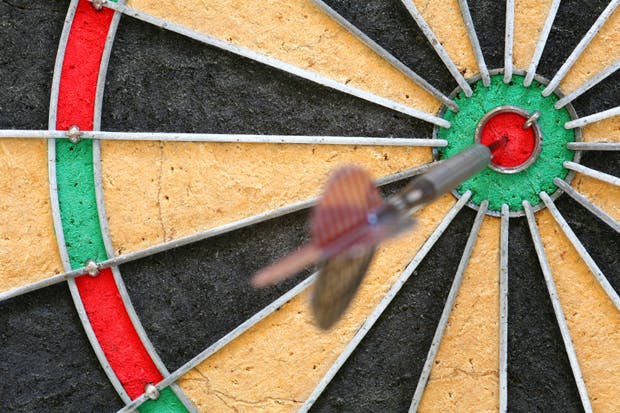I have always been intrigued by the scoring systems for different sports, and the degree to which they contribute to the enjoyment of any game. As a friend of mine remarked, had tennis been given the same scoring system as basketball it would be tedious to play, and even worse to watch. Once you glanced at your TV and saw Djokovic leading Murray ‘by 57 points to 31’, you would shrug and change channels to something more gripping, like an unsubtitled version of Last Year at Marienbad.
Tennis scoring isn’t quite socialist — one player can demolish -another — but in such cases the contest is over in a mercifully short time. There is, however, a kind of social security system in the scoring of tennis which means that for the duration of any game, the losing player feels he is still in with a chance. It’s genius, frankly.
Another feature found in the scoring of many good games is where greedily aiming for the highest score comes with a high degree of concomitant risk. Shove-ha’penny works this way, as does bar billiards, where the highest-scoring pot sits behind an unstable black mushroom (technically a ‘skittle’), which will wipe your entire score if knocked over.
This may explain why darts is an enjoyable spectator sport while archery isn’t. In archery the scoring is concentric. You simply aim for the bullseye, which scores 10, and if you narrowly miss you get 9. Miss the 9 and you get 8. The only strategy of the game is to aim for the 10 and hope. It is a perfectly logical scoring system, but it doesn’t make for great telly. The dartboard, by contrast, is not remotely logical, but is somehow brilliant. The 20 sector sits between the dismal scores of 5 and 1.
Most players, even ungifted amateurs, aim for the triple-20, because that’s what professionals do. However, for all but the best darts players this is a mistake. If you are not very good at darts, or if you are drunk, your best opening approach is not to aim at triple-20 at all. Instead aim at the south-west quadrant of the board, towards 19 and 16. No, you won’t get 180 that way, but nor will you score 3. It is a common mistake in darts to assume you should simply aim for the highest possible score. You should also consider the consequences if you miss.
So it is in life. Many real-life decisions have a scoring rubric more like darts than archery. In deciding, say, whom to marry, aiming for the best may be less important than avoiding the worst. ‘Satisficing’, as the polymath Herbert Simon named it, is the strategy where rather than trying to maximise an outcome, you seek a pretty good all-round solution with a low chance of disaster.
There seems to be some psychological evidence that people who ‘satisfy’ are happier and less regretful than people who try to ‘maximise’. It certainly isn’t obvious that maximising is always best — evolutionary instinct seems to incline towards satisficing. Much human behaviour which is often derided as ‘irrational’ is evidence of a very clever satisficing instinct. Repeating a past behaviour, or copying what most other people do, may not be optimal, but is unlikely to be disastrous.
As Simon observed, ‘Decision makers can either find optimum solutions for a simplified world, or by finding satisfactory solutions for a more realistic world.’
Finding an optimum solution for a simplified world is a pretty good description of what computers do best. Finding satisfactory solutions for a realistic world is a good description of what people do well. One downside of the growth in computational power is that the second approach is becoming dangerously subordinate to the first.
Got something to add? Join the discussion and comment below.
Get 10 issues for just $10
Subscribe to The Spectator Australia today for the next 10 magazine issues, plus full online access, for just $10.















Comments
Don't miss out
Join the conversation with other Spectator Australia readers. Subscribe to leave a comment.
SUBSCRIBEAlready a subscriber? Log in